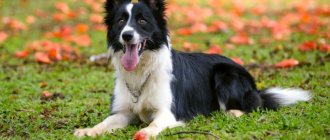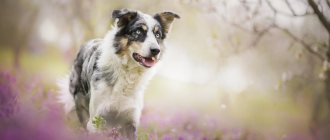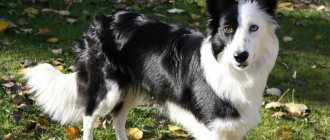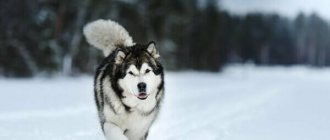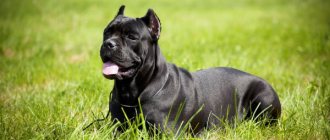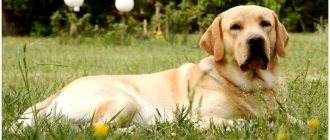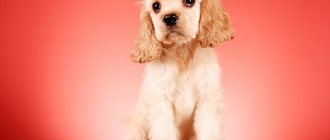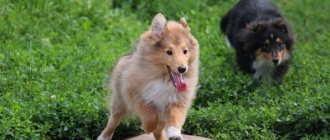The Border Collie is a dog breed native to the UK that is considered the smartest dog in the world.
This dog has a lot of positive qualities that you will not find in many other breeds. The breed was bred to be an excellent shepherd and could be entrusted with any herd without human control. She simply doesn’t need it; the dog knows its responsibilities very well.
This is the best friend, a devoted comrade, a cheerful mischief-maker who will not let you and your children get bored. Next, we’ll talk in more detail about the character and physiology of the pet.
Care and maintenance
Caring for individuals of this breed is not difficult, but during shedding you will have to spend a lot of time cleaning, because dogs shed profusely and litter everything around with hair. Fortunately, this happens seasonally and can be dealt with. When you decide to get yourself a pet, learn how to properly care for your collie's coat, paws and claws, ears and eyes.
How to properly care for your fur
It is recommended to bathe your Border when he is not shedding once a month or as needed. You need to comb it once a week, using a metal brush - this will help avoid tangles and give your pet a well-groomed appearance. Remember that you cannot comb dry wool: you must first dilute a little conditioner in warm water, then sprinkle the resulting mixture onto the wool. During the molting period, the fur will have to be brushed almost every day, but this will not help much, because with frequent brushing it grows more intensively.
Experienced breeders do not recommend using slicker brushes and furminators, because they injure the hair structure, have a bad effect on the skin, and tear off the undercoat, which immediately begins to grow again. You can get rid of fur during the shedding period in the following way:
- dilute a little shampoo in a basin with warm water, place the collie there, then wet the wool well with the soapy solution;
- change the water, place the pet in the soapy solution for at least 5 minutes;
- rinse the wool thoroughly with clean warm water;
- when the rinsed water becomes clear, place the dog in the solution with conditioner and hold for 10 minutes (it is not necessary to rinse off the conditioner);
- wrap a clean dog in a towel for half an hour;
- dry the wool with a hairdryer;
- comb the fur with a massage brush - dead hairs will fall off on their own.
The procedure can be performed every week for a month. The shedding will pass, and the pet will grow new hair. When the main part of the hair falls off, be sure to start giving your collie coat vitamins - the course is 2-3 weeks. Remember that the border collie's diet must be correct and balanced - this is the only way you will save your ward from excessive shedding.
Claws and paws
Nails need to be trimmed once a month using a guillotine nail clipper.
It is important to remember that the front paws have a fifth toe - the claw on them is short and does not wear off when walking. After a walk, the paws should be wiped with a wet cloth, and always inspect them, checking for cuts on the pads
In winter, after a walk, it is recommended to wash the paws especially thoroughly and do not let your pet lick the snow off them - it contains reagents for melting, and this can be fraught with poisoning.
Ear and eye care
The inside of the ear should be wiped once a week with a damp cloth. A healthy dog's skin will be rash-free, smooth, and pink in color.
It is important to ensure that there is no unpleasant odor from the ear and that wax does not accumulate in it. If you notice excess wax, redness of the ear or fluid leaking from it, you must immediately take your pet to the veterinarian
It is important to provide your pet with proper eye care: it is recommended to examine them regularly; to prevent souring, they should be wiped every week with a weak tea solution. If the animal's eyes become very sour or there is strong tearing from them, do not self-medicate, but contact a veterinarian
Nutrition
The dog requires high-calorie food rich in vitamins and microelements. Leading food manufacturers produce special product lines for border collies. Premium food mixtures contain the following components:
- High-quality proteins, carbohydrates and fats of animal origin;
- Omega-6 fatty acids;
- L-carnitine;
- Calcium, phosphorus and zinc.
You cannot skimp on food for your border collie. Cheap food will cause allergies and chronic diseases.
Natural diet for border collies
If you decide to feed your animal natural products, then you need to include the following ingredients in your dog’s menu:
- Boiled meat (veal, chicken, turkey, lamb).
- Offal (tripe, heart, lungs, liver).
- Sea fish (capelin, trout, anchovy).
- Porridge (rice or buckwheat).
- Boiled vegetables (cabbage, pumpkin, cabbage, zucchini).
Veterinarians do not recommend feeding pork to your dog. Fatty meats can interfere with liver function and cause stomach upset. Fish must first be cleaned of bones, and grains must be thoroughly sifted. During the period of intense physical training, the animal needs to be given special fortified complexes. It is better to give food and drinking water at room temperature.
Safety
It is important to ensure the safety of your home. Given the puppy's curiosity, possible dangers for him should be considered.
Dangerous objects that may attract the dog's attention should be removed. First of all, such dangers include electrical wires, which dogs love to chew, as well as sharp objects that are lost on the floor and can be accidentally swallowed by the puppy (pins, buttons).
You should remove plants that are poisonous to animals, household chemicals, plastic film, and foil, which the dog can pull out of the trash can if there are food particles left on them. Chocolate is toxic to dogs, so you should not leave it in the room where your dog can reach it.
If there are stairs in the house, then you should not allow the puppy to move along them. Such exercises negatively affect the formation of joints and the skeleton of a growing body.
It is important to prevent movement on slippery surfaces
Border collies are very excitable, their attention can be attracted by a sound from the street, a flying bird, after which the dog can jump and fall over the side of the balcony if access to the balcony is free and it is not glazed.
It is important to provide a safe space for your dog to rest. Buy a comfortable bed, bowls and accessories for walking and playing
Buy a comfortable bed, bowls and accessories for walking and playing
It is important to provide a safe space for your dog to rest. Buy a comfortable bed, bowls and accessories for walking and playing
When to start training a dog
As soon as a collie puppy appears in your home, immediately begin to build a relationship with him. From the first day it is necessary to provide him with everything he needs: bowls for water and food, collar, leash, bed, suitable food, toys and of course treats. You need to give him a lot of attention so that he feels safe and begins to trust you. From a very early age, a collie puppy needs to be introduced to commands. In addition, in the first months it is necessary to study commands both at home and on the street. First, the puppy must remember its name. We wrote how to choose a suitable nickname in one of our articles. The name should be short, easy to remember and the dog should be called only by it. When the pet has already mastered its name and finally begins to respond, then we move on to commands. By the 3rd month he should master the following commands: “Ugh!”, “Come to me!”, “Place!”, “Nearby!” and “Fetch!” (optional). Then you can move on to the rest, of course, if you need them.
How much do border collie puppies cost?
Thanks to their innate qualities, Borders have become ideal dogs that can herd huge herds of livestock. Every puppy can become your true friend if you devote the proper time to training and education. It is better to start the educational process from childhood, so when deciding on such a purchase, you need to know how much a border collie costs. So, you can buy a puppy from private sellers for 20-25 thousand rubles.
The cost of a four-legged animal in a nursery is about 45 thousand rubles, but for this price they sell individuals unsuitable for breeding or participation in exhibitions. A dog that can produce high-quality offspring will cost you 60-70 thousand rubles. If you need a representative of the breed who has excellent data for exhibitions and who will produce puppies that meet all the stipulated standards, then be prepared that you will have to pay at least 95-100 thousand rubles for the future champion.
How to choose a puppy
The Border Collie is an exotic breed for Russia. It is better to buy puppies from nurseries that have good recommendations.
When choosing a puppy you need to consider:
- A healthy puppy is active and tries to make contact with others.
- The dog must have a dense coat, a moist nose and moderate fatness.
- The future pet should not show aggression towards humans.
- Clean ears and eyes indicate the health of the animal.
Description of the breed with photos
According to the FCI breed standard, the Border Collie is a well-proportioned, light-boned dog.
Other characteristics include the following:
- the head is wide, proportional to the body;
- muzzle of medium size, narrowed towards the nose;
- the lobe is evenly colored;
- scissor bite;
- the teeth are strong, the upper ones cover the lower ones. The fangs are powerful and large;
- The ears are triangular and set wide apart. Acceptable: stand or half stand;
- The eyes are dark and oval in shape. Merle-colored dogs are either blue or have brown spots;
- the tail is fluffy, set low, of medium length;
- the neck is proportional, with developed muscles, but not wide;
- limbs are straight, located parallel to each other (turning inward is not allowed);
- round paw pads;
- claws black or dark brown.
The purebred Border Collie moves easily, freely, and rhythmically. The throw of the paws is not wide, but the animal is capable of developing high speed.
Breed variety
The international standard describes two types of representatives of the breed:
- smooth-haired;
- long-haired
The differences between these varieties are only in the length and structure of the pile.
Size and weight
Border collies are not classified as large breeds. The standard stipulates height at the withers:
- 47-52 cm for females;
- 50-53 cm for males.
Best Raising a Husky?
The weight of an adult varies between 15-20 kg.
Color and coat type
Long-haired dogs have a richer coat than short-haired dogs. The Border Collie's undercoat is dense and softer than the outer coat. In the neck area and on the limbs the hair is longer than on the rest of the body. It forms a “mane” and “pants”. When a dog is calm, its tail resembles a fox's.
A wide variety of colors are allowed:
- black;
- red (various shades);
- brindle;
- chocolate;
- marbled (blue merle).
The spots are usually located in the area of the paws, chest, and tail. Some Border Collies may lack the primary color. That is, if areas of colors (for example, black and red) are distributed approximately evenly, this is acceptable.
Border Collie: standard
If you judge the breed from the photo, border collies are unremarkable. Many even mistake them for ordinary yard dogs. After all, she has a simple appearance, no outstanding physical characteristics or unusual color. The first breed standard was adopted in 1915. But for more than half a century it was still changing. The final opinion on how these dogs should look was established in the 60s of the 20th century. And the breed was registered in the international FCI classification only in 1977. Belongs to the group of shepherds, the shepherd section.
Border Collies are proportionally built and medium in size. These are graceful, but strong and muscular dogs. The height of the Border Collie varies depending on gender. The size of females is 47-52 cm, males are larger - they reach a height at the withers of 50-53 cm. The weight of adult border collies is no more than 15-22 kg.
The photo shows what the appearance of this dog should be.
Head
The skull is proportionally folded, wide, slightly smoothed in the occipital part. The muzzle is shaped like a fox, tapering towards the nose. The stop is well defined, located exactly in the middle of the head. Scissor bite, strong jaws. The ears are medium-sized, triangular, widely spaced. The standard allows both standing and semi-standing with hanging tips.
The Border Collie's eyes are oval, large, and set wide apart. They are usually brown in color. But light-colored Border Collies are blue. A characteristic feature of this breed is its intelligent, calm, attentive gaze. Lips are dry, no jowls. The nose is medium-sized, usually black. Chocolate Border Collies can be brown.
Torso
The Border Collie has a harmonious, elongated body type. The chest is wide, the ribs are rounded, protruding slightly. The neck is muscular, elongated, with a slight bend. The line of the back decreases towards the lower back, the croup is elongated and sloping. The tail is fluffy, saber-shaped, the tip is raised up. When at rest it hangs down to the racing joints. An emotionally excited dog often picks it up, but never throws it over its back.
Limbs
The limbs are strong, muscular, set parallel. The special position of the shoulder blades allows you to move in a bent position. Representatives of the breed run easily, confidently, and almost never raise their paws. But they are capable of developing high speeds and easily overcome high obstacles. The paws are oval, the toes are strong, the claws are short and strong.
Wool
The coat is soft, dense, heavy, with a thick undercoat. It is characterized by water-repellent properties and keeps the dog warm. Even in short-haired individuals it is elongated on the inner surface of the paws, tail, and neck. There are two types of Border Collie dogs based on length.
- The Smooth Border Collie has a rough, short coat. But her undercoat is still thick, even double. Possible feathers on the back of the paws, fluffy tail.
- Long-haired representatives of the breed have longer hair. The collar on the neck, feathering on the paws and the fox tail are well defined. The coat itself is of moderate length, short on the muzzle.
Border Collie colors
Both smooth-haired and long-haired representatives of the breed can have different colors. About 20 varieties are recognized as standard. All Border Collies are always white. But it should occupy no more than 50% of the body surface. White spots should be on the paws, tail, chest, and often a stripe runs along the forehead. Sometimes there are small specks in these areas. The combination of three colors is interesting: the traditional black and white are joined by tan markings on the head and paws.
The photographs show that representatives of the breed can have different colors.
The most common color is black and white. Other popular options are:
- marble;
- chocolate;
- black;
- ginger;
- beige;
- brindle;
- sable;
- grey.
It is allowed that there is no white color, but other shades must be distributed evenly over the body. The beautiful and rare color lilac or isabella is a combination of brown and blue. Monochromatic coloring is not found in this breed.
Marbled border collies look especially beautiful and unusual in photographs. They often have heterochromia, where one eye is blue and the other is brown.
Health and features of keeping a border collie
Borders have good health, and with good care they live up to 14-16 years. Moreover, even after 10 years, the dog can maintain strong teeth, activity and interest in life.
Caring for such a dog is not difficult: they do not need to cut their nails, rub their eyes, or clean their ears. Only the fur requires attention, especially during the molting period. A furminator is used to comb out dead undercoat.
Regarding walks: for an adult dog, walking 2-3 times a day is enough, taking into account the fact that at least twice the walking time will be 40-60 minutes. Nothing supernatural, they recommend walking with the same huskies a lot more.
Tricolor color
The main thing that every collie owner should remember is that this breed cannot be given many medications that ordinary dogs tolerate well. Due to the MDR-1 gene, Border Collies have altered permeability of the blood-brain barrier. Certain drugs penetrate into their brain, which does not happen in dogs without this mutation. This has nothing to do with an allergic reaction to the medicine.
Care should be taken when choosing remedies for external and internal parasites, studying the composition before use. Border Collies should not be given:
Border Collies should not be given:
- Ivermectin: antiparasitic drugs Ivomec, Baymek and others.
- Moxidectin, selamectin: drops against fleas and ticks Lawyer, Inspector Total K, Stronghold.
- Milbemycin: tablets for worms Milbemax, Milprazone, Helmimax.
- Emodepside: Profender deworming tablets.
The full list of prohibited drugs is much more extensive, but this is a topic for a separate article.
If you are planning to breed, ask for a pair from your club, or consult with an experienced breeder. Among border collies, the merle color is common, for which the M gene is responsible - merle (merle).
The blue merle (blue merle) color is very popular because it looks impressive and unusual.
It is unacceptable to get offspring from two marbled dogs, since the offspring may be born with congenital pathologies: complete deafness, eye diseases, heart defects. Some puppies are born with the double merle gene (MM), and these dogs die at an early age. Borders who are heterozygous for the merle gene (Mm) can also have problems with hearing and vision, so it is better to choose a merle puppy with at least one brown eye.
Merle border collie with heterochromia. Photo courtesy of @redmerleheart
Basic commands
You will use some commands more often, others less often. But they will still come in handy to easily interact with your collie and even keep him safe in various situations.
- Aport. One of the most difficult teams. Many people perceive it as very easy and simple, but with many dogs you will have to work hard. This skill is used for other exercises: searching, searching, selecting an item and many others. Usually they are all used in service. When working out a command, “Aport” and “Give” are used, and a gesture is also used.
- Give. On the command “Give” the dog must give up the object.
- Lie. A connecting command that needs to be learned for other commands. In addition, it will not interfere at home or on the street.
- To me. You will need to use this command quite often. So start with it immediately after your collie puppy has learned his name. Never call the dog to punish, and do not scold if it comes on its own, even after mischievousness before it. This behavior on your part may alienate the animal.
- Place. A puppy or an adult dog must clearly know where his place is located. He can sleep anywhere, if you allow it, of course, but he must know this command. You can use it outside the home, marking the place with a leash or your favorite toy.
- Near. It is possible to teach your pet the “Near” command at any age, be it an adult dog or a small puppy. When you move to a new home, you should immediately think about training your puppy.
- Sit. One of the very first commands that a collie puppy should learn.
- Stand. The command is useful in everyday life, for example, for combing a dog.
- . The prohibiting command is one of the most mandatory and taming it begins from the first day the puppy appears in the house. Requiring the command “Fu!”, “No!”, “No!” - immediately stop the unwanted action.
General characteristics of the border collie
This breed, popular all over the world, is rare in Russia. Judging by the photographs, the Border Collie has an unremarkable appearance, but a very intelligent look. Belongs to the herding breeds, one of the most ancient. Therefore, they love to care for and shepherd everyone who is nearby. Border collies are unpretentious, obedient, and devoted to their owner. This is an amazing dog that senses a person’s mood and has an almost human mind. Unquestioningly follows any commands and is easy to learn.
The breed is recognizable in the photo, although it does not have an outstanding appearance.
Border Collies love to serve people. They give a charge of positive emotions, are constantly active and cheerful. They will accompany the owner when playing sports and take an active part in his life. But at the same time, the border collie is an easy-going, obedient and friendly dog. She loves children, takes care of and shepherds them, anticipates the owner’s wishes and is not annoying.
Thanks to her natural love for humanity, the desire to help those in trouble and her sensitive sense of smell, she is an ideal rescuer. And the ability to predict mood makes the breed the best for canistherapy. These cheerful, sensitive dogs help people with depression, neuroses, and children with developmental delays. They are able to carefully guide the blind, support the disabled, and carry out a variety of tasks.
In describing the characteristics of the Border Collie breed, several main points can be noted:
- according to the results of research and reviews from owners, the breed is recognized as the smartest;
- can serve as guides, in the search service, and participate in rescue operations;
- often act in films;
- friendly to everyone, gets along with other pets, but tries to herd and take care of them;
- they are very active, so they do not feel well in an apartment or on a chain;
- easy to learn, capable of mastering more than a hundred commands, even the most complex ones;
- ideal for dog sports - agility, frisbee, freestyle;
- with good care they live up to 15 years;
- Queen Victoria really liked the breed, there is even a memorial dedicated to her favorite.
The best Kennel Cavalier King Charles Spaniel in Moscow
The main characteristics of the breed can be found in the table:
| Options | Characteristic |
| Country of origin | Scotland |
| Working qualities | Shepherd, guard, watchman, guide |
| Lifespan | 13-15 years old |
| Intelligence | High |
| Aggressiveness | Doesn't show up, very friendly |
| Training | Lightweight |
| Activity | High |
| Care | Simple, unpretentious, but sheds a lot |
Even the photographs show what a smart and cheerful dog this is.
Pros and cons of the border collie
Despite their ordinary, unremarkable appearance, border collies are very popular. The following advantages of representatives of the breed can be noted:
- they have high intelligence;
- get along with other animals;
- love children;
- friendly;
- learn easily and with pleasure;
- obedient, hardworking, loyal;
- have unusual colors.
The Border Collie has few disadvantages. Many breed lovers note that there are none at all. But judging by the reviews, the following disadvantages can be noted:
- active molting;
- the desire to shepherd everyone sometimes becomes obsessive;
- these dogs are stubborn, cunning, independent and touchy, so a special approach to training is required;
- high activity requires long walks.
Therefore, this breed is not suitable for calm people, homebodies and those who have no time to walk with their pet. You cannot make a chain dog or a sofa dog out of a border dog.
You can learn more about the advantages and disadvantages of the Border Collie from the video.
Training
Collies have always been in the company of a person, therefore, they are quite smart and easy to train.
They happily follow commands, obey their master, and learn new tricks.
It is simply necessary to train collies, as their intelligence needs to be occupied, otherwise the dog will lose the meaning of its existence in the family.
Collie dogs need to know their owner in order to become a worthy subordinate for him.
Not everyone can become a leader for a collie, since you need to prove that you are strong and can react better and faster than she can to various situations.
You cannot train a collie harshly, using physical force. Dogs of this breed are smart enough to remember commands using more humane approaches.
Caring for an adult dog
Border Collie dogs are unpretentious and easily adapt to any conditions. They are not picky about food and can withstand bad weather well. It is best to get them for a country house, just place them in a large enclosure, and not on a chain. You can also keep a border collie in an apartment, but if you don't walk it, it will get bored.
At home, your pet should have its own place with bedding. It should be located away from drafts and radiators. It is advisable that the border dog can watch the owner from a place, since this dog does not like loneliness. Be sure to buy toys for your puppy, otherwise he may start chewing things out of boredom.
You need to walk your dog at least 2-3 hours a day. Without sufficient physical activity, he will lose his working qualities. It is better to go for walks in the dog park so that the pet can overcome obstacles. These dogs love to run after sticks and balls. In summer it is recommended to go to the river.
Caring for borders is easy. But they lose a lot of hair during molting. Therefore, it is recommended to brush your pet daily. But you still need to prepare for the fact that during the molting period there will be fur all over the apartment, even from short-haired varieties.
The rest of the time, it is enough to brush your pet 3 times a week. It is not recommended to use a slicker, as it damages the undercoat. Smooth Collies can be brushed less frequently, using a special brush.
It is important to ensure that tangles do not form. Collies should be bathed no more than once every 1-2 months.
Wash your paws every time after a walk.
Other care: brush teeth, wipe eyes
Pay special attention to your ears. They are surrounded by fur and dirt can accumulate there.
They need to be wiped with veterinary lotion. If it is necessary to trim the claws, this should be done regularly only on the fifth toe.
Nutrition
The dog's diet should be chosen taking into account its hyperactivity. You can feed the border dog with dry food or natural food, the main thing is to choose the correct serving size. The pet must receive the necessary vitamins, minerals, and fatty acids. When feeding natural food, the dog is given additional multivitamins.
The diet should contain;
- meat, offal, poultry, sea fish;
- cereals as a source of carbohydrates, preferably buckwheat or rice porridge;
- vegetable fiber - spinach, apples, zucchini, cabbage;
- vegetable oil;
- once a week – egg, fermented milk products.
Many owners choose dry food, in which case it must contain at least 50% protein. Preference should be given to those designed for active dogs. They should contain Omega 3 fatty acids, fiber, vitamins, preferably chondroitin to support joints. The composition should not contain soy, corn and wheat, as these dogs are prone to allergies.
Health
Border coli are very hardy and strong animals. They are in good health. But some individuals have congenital or acquired diseases:
- hip dysplasia;
- osteochondrosis;
- epilepsy;
- atrophy or detachment of the retina;
- allergies, usually to medications;
- cardiovascular pathologies.
Blue-eyed puppies are often born blind. When purchasing, you need to check your eyesight - the baby must react to movement and light. This pathology can appear by 2 months, so it is recommended to buy a puppy older than 10 weeks. Acquired pathologies usually appear due to improper care. Obesity and heart disease are especially common. To start treatment on time, you need to regularly visit the veterinarian.
The video will tell you more about how to care for representatives of the breed:
Barks but doesn't bite much
Border collies are irreplaceable shepherds who are capable of acting intelligently and harmoniously even without the participation of the owner, but they are poorly suited for the role of a watchdog. When the sheep do not obey, the “Einsteins” even lightly bite their legs in order to wean the oaky mammals from stubbornness or to move the inhibited thinking of their charges.
Being chained to a booth with a short piece of chain is a fate that can turn a cheerful and active dog into a melancholy and gloomy creature that has lost the meaning of life.
These lively creatures cannot live without movement, but aggression is not their style either.
If it concerns a herd, and the intruder is a wolf, fox or other animal, then there will be no mercy for him, but gaping at people is not quite in the rules of the border collie, although setting off a shrill “dog alarm” is quite within his power.
On a three-point scale, the watchdog qualities of this breed can be assessed as a two with two pluses, however, with the caveat that a chain is strictly contraindicated for a border collie, that is, serving as a guard is by no means its strong point, because hostility towards humans is absolutely absent in the “Einstein” genome!
Border collie: photo of the dog, price, description of the breed
Description of the breed
Beginners who decide to have a pet after looking at a photo of a Border Collie are often disappointed. “Classic” dogs have a mediocre appearance: black and white color, medium-length hair and a regular dog face. The feelings of many change in the opposite direction after personal communication with the dog: a penetrating gaze, restrained behavior, determination, and friendliness do not leave anyone indifferent.
Appearance
The height of a purebred adult male is 48-56 cm at the withers, females - 46-53 cm. The body weight of males reaches an average of 14-20 kg, females - 12-19 kg. The average life expectancy of representatives of this breed is about 16 years - for individuals of such dimensions this is a lot. Collies attract many people with their relatively small size, convenient for keeping in an apartment, and elegant and proportional constitution.
Pedigree pet standard
Collie cannot be confused with any other dog. A purebred border collie dog has the following distinctive features:
- The eyes are small, oval in shape, and have a brown iris. Marbled collies have light irises;
- the muzzle is strong, the head is elongated. The nose is black, but can be brown or gray, depending on the color;
- the ears are small, widely spaced, triangular in shape, always erect;
- neck – medium length, with developed muscles;
- the teeth are snow-white, small, scissor bite, lips have black pigmentation, fit tightly to the jaw;
- the body is elongated, muscular, the ribs are barrel-shaped, convex, the sternum is wide;
- the paws are parallel to each other, the hips are long and slender, the hock joints are well defined;
- The tail is gorgeous - saber-shaped, covered with long thick hair. While moving, it twists and hangs down when at rest.
Coat type
Individuals of the breed come in two varieties - short-haired and long-haired. The top layer of hair is thick, a little hard to the touch, the bottom layer is a dense undercoat, which is silky and soft. Representatives of the breed with long hair have a pronounced, chic mane and a beautiful tail, reminiscent of a fox in appearance. The hair on the metatarsals, ears, muzzle and forelimbs is short.
History of the origin of the breed
The first records of the dog date back to 1881.
Then a shepherd dog of Anglo-Scottish origin was described. In 1884, a competition of herding dogs was held in England, in which the dog Old Hemp became the winner. It is he who is considered to be the founder of the breed. However, the dog was registered much later - in 1915. Its initiator was the Englishman James Reid. He gave the breed an interesting name - “Border Collie”. Since the dog was bred in the border area located between Scotland and England, this area is considered the birthplace of the breed. There is an opinion among cynologists that the ancestors of these intelligent animals were Viking dogs. They were crossed with Welsh dogs living in the area, resulting in an unusual breed of dog.
Initially, dogs were used to guard sheep. Thanks to their developed intelligence, border collies could simultaneously perform several functions. They were guards, shepherds and hunters.
To form the breed, breeding animals were crossed with local shepherd dogs
When selecting animals, special attention was paid to physical characteristics, intelligence, behavior and health. The breeders needed the dogs to cope with the assigned duties - transferring the cattle on command, directing them to the pens
Best History of the Briard Breed
The manifestation of initiative was welcomed, because in order to return a sheep that had strayed from a large herd, the dog had to be smart.
The Border Collie dog breed was recognized by the Kennel Club of England only in 1976, and by the FCI in 1988. Today the breed has an official name - Border Collie, where Border is translated from English as border, and Collie in Celtic means herding dog.
History of name and types
The history of the name of the collie breed is a little confusing and not precise. There is no clear information anywhere.
The breed is divided into 2 types:
- long-haired appearance;
- smooth-haired appearance;
- Bearded Collie or Birdie.
- Border Collie;
- Sheltie.
Description of the Border Collie breed
- height at withers – 54 cm;
- weight – 21 kg;
- life expectancy – up to 16 years;
- head - an elongated skull without a pronounced occipital protuberance, the cheekbones have a slightly convex structure, a prominent transition from the forehead to the muzzle;
- nose – pigmentation can be black, gray or brown. The color depends on the color of the fur coat and is in complete harmony with it;
- eyes – oval shape, expressive look, brown color. Dogs with marbled coats may have light-colored eyes;
- ears – medium size, set wide, triangular in shape, erect;
- teeth – scissor bite, white teeth, a full set, the upper jaw slightly covers the lower jaw, the lips fit tightly to the jaw, have black pigmentation;
- neck – muscular, medium length;
- limbs - set parallel to each other, wide, strong, shoulder blades well inclined, elbows tightly adjacent to the body, long hips, well-defined hock angles, toes gathered into a tight ball, claws, as a rule, white or black;
- body – muscular, slightly elongated, wide chest, barrel-shaped ribs;
- the tail takes a saber shape, is covered with a thick fur coat, and is set quite low. When moving, it reaches the hock joint, when at rest it hangs down and curls slightly at the end;
- dynamics - light and graceful movements, with active movement, the pet unnoticedly lifts the sticks off the ground, one gets the impression that the dog is sneaking at high speed;
- wool - representatives of the breed are divided into those with long and short fur coats. The main hair is hard and thick, the undercoat is soft and silky. Dogs with long hair have a distinct mane and a fox-like tail;
- color - the palette of wool can be absolutely any, the main rule is that white color should not be dominant. The classic colors of the dog are black, dark and tan, marbled, and brown.
pros
The main characteristics are extremely positive, but there are several important advantages to pay attention to
- Intelligence and training. Enough has been said about collie mental abilities. It follows from this that they are easy to train and quickly master commands.
- Working abilities. You can use Border Collies not only as friends, but also as colleagues. This is true for service people. Another interesting fact is that you can take your dog with you hunting and fishing.
- Possibility of home maintenance. There are breeds that cannot be kept at home. These often include huskies and shepherds. This impossibility is most likely due to the fact that not everyone can adjust the microclimate of the house to the atmosphere of the dog. There will be no problems with a collie! They were bred to help humans, and therefore get along well with people.
- Suitable pet personality. Everyone wants just such a dog - cheerful, loving to run and play. With a border collie you can be like the movies, play fetch with the dog. Also, a trained pet is presented as an advantage over friends and acquaintances - they say, look how my Bobik can do it! He knows both “to me” and “to sit”!
- The average size. To be honest, keeping a large dog in the house is an incredibly difficult task. And keeping a large dog in an apartment is simply unrealistic. It is extremely difficult to provide comfort and at the same time make sure that the pet does not destroy the entire home. It is recommended to keep small or medium-sized dogs in apartments. The Border Collie fits this criterion - the breed is classified as medium.
Positive and negative qualities of the breed
The strengths of the breed are considered
- Friendly character.
- Good learning ability.
- Beautiful exterior.
- Endurance and determination.
The obvious disadvantages of the breed are
- Inability to live in an apartment.
- Slow maturation (the dog’s character is finally formed only by the age of 4).
- Hyperactivity and constant need for attention. The dog needs to spend at least 6-7 hours every day.
Coat type and color
The Border Collie, according to its description established by the standards of international cynology, has two types:
- Smooth-haired;
- Long-haired.
Long-haired animals have a good undercoat; the fur itself is rougher to the touch than the inside. Quite smooth, glossy appearance. Representatives have a beautiful “mane” starting from the head and hardening the neck, on the paws they have a longer “pants” type, the tail in a lowered state resembles the tail of a fox.
The coat looks rich; in color, more than 45% white is not allowed. Usually, there are spots on the chest, paws or a little on the tail. If there is a lot of white color, then the dog is considered a defect and is not allowed for breeding.
Color
- Black (there may be white spots);
- A rich brown, fiery Border Collie with a red color will also have a brown nose color.
- Blue - merle (marble color);
- Brindle (similar to dark, but with three colors of the brindle type), from a distance it appears black and red;
In some colors of Border Collies and their representatives, the main color may be absent, that is, the dog according to the standard should not contain a lot of white hair, but there may be combinations that do not fit the descriptions of the main colors - there is nothing wrong with that.
The wool is odorless and quite easy to care for, both during the shedding period and during everyday life.
The colors of the merle collie are considered very elegant; often their representatives have unpainted eyelids, lips and nose. Blue eye color, or a splash of brown on blue. Shorthaired Borders usually have a predominant tan color and are easier to care for.
Interesting Facts
- A dog's thinking is comparable to the intellectual development of a two-year-old child.
- A border collie named Rico is considered the smartest dog in the world, he knows 200 words and various commands.
- The animal can perform work tasks for 12–13 hours without rest.
- The dog has a "shepherd" instinct. She tries to guide cats, children and small rodents. The “shepherd” character can be corrected with training.
- A hunting dog has a psychological effect on sheep with a stern look and a special half-bent posture. One Border Collie can control a herd of up to 100 animals.
- The dogs are used to disperse birds and small animals that run across runways and golf courses.
- A dog named Stryker can use his paw and muzzle to turn the handle that lowers the window in a car door. A dog can fully open a car window in 15 seconds.

